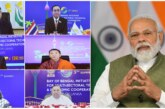The 21st-century is purported to project dominance of Asia. The 19th century was thought of as belonging to Britain and the 20th century to America. It is believed by many now that the 21st century belongs to Asia. The utter market size and growth potential of China and India along with other resilient economies of Japan, South Korea and Southeast countries place them at the centre of the Asian century. Over the past two decades, most of these countries have managed to grab a sizeable share of the global economy. When adjusted for purchasing power parity, the Indian economy is now roughly the same size as Japan’s. One Goldman Sachs estimate suggests that India’s economy will surpass the US economy by 2043 and India’s population is expected to pass China’s in less than two decades.
India-Japan Relations
India’s relations with Japan had remained highly asymmetrical until the 1990s. The Cold War period proved instrumental in envisaging a strategic-political void between the two countries. Economically, India was too inward-looking to be of any great interest to Japan. The post Cold-War realities, however, had proved convenient for both sides in forging new strategic bonds. The subsequent period was characterized by exchange of high-level visits and by the first decade of the 21st century witnessed India’s emergence as a significant beacon on the Japanese investment radar.
Keeping in consonance with its growing economic strength and foreign policy objectives under its ‘Look East Policy,’ significance of Japan increased immensely for India. The year 2007 was declared the Indo-Japan friendship year. Undoubtedly, the economic and political interaction between New Delhi and Tokyo continued to flourish; nevertheless, there as relatively small bilateral flow of goods, services, human resources, capital and information.
Bilateral trade between Japan and India increased from US$3.7 billion in 2002-03 to US$6.5 billion in 2005-06, and US$10.9 billion in 2008-09. While Japan ranks 10th among India’s export destinations, India stands 26th among Japan’s export destinations. India’s exports to Japan grew at a rate of 34.7 per cent in 2007-08, but in 2008-09 the rate fell to 21.5 per cent on a year to year basis, probably due to the global financial crisis. Imports from Japan, however, grew at a rate of 37.5 per cent in 2007-08 and 24.6 per cent in 2008-09.
The terms of trade are in favour of Japan with a margin above US$7 billion. Japan is among India’s top five trading partners – with a potential to reach US$14 billion by 2012 – as both countries are involved in several developmental projects.
The bilateral relations between India and Japan have entered into a new phase in the aftermath of the visit of Japanese Prime Minister Shinzo Abe to India in the closing part of January 2014. The visit has opened up new vistas to dramatically expand the scope of bilateral cooperation to include the politically sensitive northeastern states of India, where Japanese companies will have the opportunity to help the development of the northeast specially to build roads, and aid agriculture, forestry and water supply and sewerage in these states.
Japanese companies have also been invited to help develop a new port in Chennai, which would be used to improve India’s sea-route connectivity. Japanese assistance for Chennai port is also aimed at giving teeth to a new sea-based route that would start in Chennai, and end in Dawei port in Myanmar’s Tanintharyi region. The port is being developed by Thailand.
It is worth mentioning here that in 2012, Thai PM Yingluck Shinawatra had promised PM Manmohan Singh that Thailand would pump in a massive $50 billion into Dawei, making it a bigger investment than China’s in Gwadar or Hambantota.
The development of a new port in Chennai would serve to connect the industrial centres of southern and western India with Southeast Asia. In addition, Japan’s investment in the Bangalore-Chennai industrial corridor would find easy outlet from Chennai. The India-Japan team for economic projects is ultimately placing pieces together to build a multi-polar Asia, a declared strategic intent of both countries.
Both countries have expressed willingness to work together to develop infrastructure in other regional countries as well. This would have the double benefit of being a power projection for both countries in South Asia; it could be an effective counter to the Chinese juggernaut. For India, this would be an added advantage because it always falls short in delivering quality infrastructure by a moribund public sector system. Induction of Japanese funds and expertise is just what India needs.
As part of the trilateral dialogue between India, US and Japan, a trilateral highway linking India, Myanmar and Thailand (the ambitious draw it further to Hanoi, Vietnam) is likely to see more Japanese and US interest. This is an India-led project due for completion in 2016, but by itself, India is unlikely to make the target.
India has invited Japan to help develop a huge thermal power plant in Trincomalee in Sri Lanka. India’s Foreign Minister Salman Khurshid recently inaugurated the project, which India has promised would be a better, cheaper power project than the one developed by the Chinese in Norachcholai. India and Japan could also jointly develop the strategically crucial oil terminals in Trincomalee. A joint development project with Japan would solve many issues with Colombo.
Japan’s JICA has promised to help India’s Export-Import Bank develop more attractive funding packages for Indian projects in regional countries. India reckons that with Japanese help, it can up its own game in the neighbourhood. In the power play that is quietly underway in Asia, India has made Japan the centerpiece of its strategic outreach.
Japan is now working with India to improve India’s industrial infrastructure, not just to increase commerce directly between the two countries but also to help India become a hub in the multi-country supply chain that spans the Asia Pacific. Japan could benefit from the software capacity shown by India and Indians in America’s Silicon Valley and abroad. Japan, which has focused on custom-made software, has not been able to step up to the plate to produce software for exports. Japan needs to work with Indian firms or help Indians set up their own firms within Japan to become providers, rather than just hiring individuals who may be absorbed in a firm’s traditional way of doing things.
Despite the growing friendly political and strategic relations between the two countries, India has been, and remains, a tiny part of Japan’s global trade. Concurrently, Japan is a relatively minor trading partner for India, accounting for just 2 per cent of India’s exports and 2 per cent of its imports. Unless India overcomes infrastructural deficiencies, and Japan overcomes structural flaws — resisting imports from competing firms — the ‘boom’ in economic relations may remain just talk.
Role of SMEs
The SMEs, comprising over 90 per cent of total enterprises in most of the economies around the globe, are credited with generating the highest rates of employment growth and account for a major share of industrial production and exports. The SMEs play a pivotal role in India too in the overall industrial economy of the country. This makes the SMEs significant for realizing the objectives of growth with equity and inclusion.
Guwahati in Assam is well placed in terms of entrepreneurship development when compared to the other states in the Northeast owing to its upscale market and good road/ rail connectivity and as such it is naturally placed to lead the entrepreneurial activities and attracting large scale investments. Other North Eastern states also present congenial atmospheres for SMEs and the local populace prefers light industries, as opposed to heavy and polluting industries that create big tussles among the different stakeholders of the industries concerned and harm the ecosystem.
A recent study named State Level Reforms – Increasing Investments in North East jointly undertaken by FICCI and the Konrad Adenauer Foundation (KAF) underlines the condition for constructive dialogue and engagement with policymakers and the administrative machinery in Northeast and the steps that need to be taken to harness the true potential of the region. The availability of the promising opportunities in the Northeast has spurred industry chambers like CII, FICCI to focus increasingly on this region to score well by infusing energy in SMEs, supported by local entrepreneurial skills. The expansion of SMEs in the Northeast will proportionally generate quality employment and will also check outbound migration.
Broadly speaking, all the states of the Northeast region, despite having many commonalities, are distinct in their own ways. Thus, keeping this diversity in mind is also essential for policy makers and prospective entrepreneurs. Under the existing circumstances, a greater adjustment is called for from industries for the local conditions prevailing in the entire Northeast. With the expansion of infrastructure and completion of corridors, the growth of SMEs will be the one among many desirable outcomes, which is going to shape the future of the very promising Northeastern region of India.
Viewed in a broad perspective, the SME sector has been faced with a vast array of problems like the purchase of raw materials, manufacturing of products, marketing of goods or raising finance. The SMEs are faced with intensified competition – both in domestic and overseas markets. The SMEs in India, while trying to cope with these challenges, are also making efforts to improve and sustain competitiveness through rational cost optimization, improved quality, offering better choices by introducing innovative measures and upgraded technology.
According to a CII-PWC report-Innovation-Changing the MSME landscape: “Statistics are already emerging on the increasing importance of innovation and its scale and scope among the country’s firms today.” Also, a National Knowledge Commission of India study reveals that 42 per cent of large firms and 17 per cent of MSMEs have introduced ‘new to the world’ innovations during the course of their business. 17 per cent of the large companies rank innovation as the top strategic priority and 75 per cent rank it among the top three priorities. So innovation is an area, where light industries are making the voyage with positive outcomes. The SMEs functional in the Northeast should also make strides to catch up with this essential trend.
An impressive growth in the service sector has helped in the sustenance of high annual growth rate in excess of 8 per cent in the Northeast in the past decade. As early efforts of unsystematic heavy industrialization mostly failed in the region, manufacturing became dominated by SMEs in due course of time. The state of Assam is better in terms of entrepreneurship development when compared to the other states in the Northeast. With an upscale market and good road/ rail connectivity, Guwahati is naturally placed to lead the entrepreneurial activities and attracting large scale investments. But it is also true that the rest six states also present favourable atmospheres for SMEs, as the concern for environmental degradation is quite high among the local population.
In the wake of promising growth opportunities being afforded by Northeast, the national industry chambers such as CII, FICCI are increasingly focusing on this region to score well by infusing energy in SMEs, supported by local entrepreneurial skills. The spread of SMEs in the Northeast will proportionally generate quality employment and will also check outbound migration. The growth of SMEs will be the one among many desirable outcomes, which is going to shape the future of the very promising Northeastern region of India.
Conclusion
Enhanced political and economic interaction between India and Japan, especially Japanese investment in India’s infrastructure development in the North-East region of India, can bring India closer to South-East Asian countries geographically, economically and strategically. The growing cooperation between New Delhi and Tokyo and their mutual joint projects in other countries of the region can help realize the motto of making this century as an Asian century.
In order to enhance mutual trade and economic interaction, both sides are required to identify each side’s surplus and deficit aspects of commodity exports and imports. Interestingly, items that don’t fit Japan’s needs dominate India’s exports. Out of a total of US$300 billion in exports in 2012, its biggest export was petroleum products at US$56 billion (20 per cent of the total). But Japan’s own refiners dominate the production of petroleum products and so Japan imports little. Until India becomes much more adept at exporting manufactured goods, Japan and Japanese affiliates overseas will not be a good market for Indian exports.
Japanese firms also prefer to import manufactured goods from their own affiliates overseas rather than from indigenous firms. Japanese affiliates in Asia have accounted for the lion’s share of Japan’s increase in manufactured goods from Asia over the past decade. Japan’s Ministry of Economy, Trade and Industry calls these goods ‘reverse imports’, and they have almost doubled from 15 per cent of Japan’s total manufactured goods imports in 2001 to 27 per cent in 2012. It is in this regard that SMEs are called upon to play crucial role in cementing the economic and technological bonds between India and Japan.
by Dr. Arvind Kumar, President, India Water Foundation



